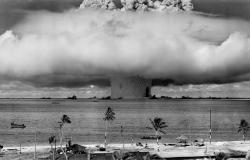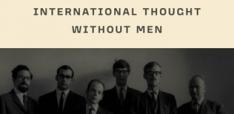Oppenheimer: Man, Myth, and Movie – A Comment

Scott Montgomery explores the major biopics' lack of science and a certain scientist whilst ultimately praising its ambition.
Oppenheimer the film deserves all the discussion and a good deal of the acclaim it has received. My comments are meant to fill in gaps and pose questions. Some points overlap with other recent commentary, for example in The Bulletin of the Atomic Scientists, whose Board of Sponsors Oppenheimer once sat on.
The film, it seems to me, is a work of art with real gravity of purpose, memorably achieved. It is work not only about a period of history epochal in importance but too often forgotten in a new century. Its timing is not only good, but necessary. The world’s nuclear arsenals are growing once again, and arms control has largely collapsed. While the film does not address this, it brings forward issues that lie behind it, that have never left the stage of the nuclear era. Among them: the relation between science and war, science and the state.
These issues appear often in the film, just as they did for the American public well into the post-war era. Though they are handled well, with the drama they deserve, there are things missing. What we do not fully learn from Oppenheimer is that the Manhattan Problem was a massive industrial effort involving hundreds of individual sites and whose most difficult challenge was not really the physics (given how many brilliant people there were) but instead the production of two highly fissionable isotopes—Uranium-235 and Plutonium-239. For this, huge facilities had to be conceived, designed, and built, with hundreds of thousands of workers ultimately put to work. The film barely hints at this, using instead an elegant, but only suggestive substitute: two fishbowls (no labels on them) to which Oppenheimer weekly adds marbles, gauged in number to indicate progress.
Another issue the movie foregrounds is the existential problem of humanity giving itself the power to self-annihilate. Oppenheimer’s writer and director, Christopher Nolan, has said he feels his subject is “the most important person who ever lived,” which, whether a momentary verbal impulse or not, implies the sobering truth that the bomb ended a very long period of innocence in human history. Hinted at, moreover, is that this was itself only the beginning. Progress in the potential for global suicide has given us bio-weaponry, climate change, and (per recent claims by its creators) Artificial Intelligence.
A fourth fundamental issue, one that the film reveals but then unfortunately tries to resolve, is the capacity of modern liberal democracies to fail internally. Democracies, that is, can have elected officials but despotic bureaucrats who ruin peoples’ lives and erode the ability of government to do good. The case of Lewis Strauss, the film’s villain, is emblematic of this in a way we deserved to have revealed.
Strauss served in government as a moderate Republican starting under Hoover in the 1920s. Though against the New Deal, he was a leader for Jewish causes, arguing, in vain, for lowered immigration limits so German Jewish children could escape the Nazis. Highly capable in varied positions, he also feared and hated communism and became increasingly rigid and authoritarian after WWII, ending up in far-right circles, campaigning for Barry Goldwater in 1964.
Oppenheimer portrays Struass as a vindictive careerist brought down in 1954 by the heroic testimony of physicist David Hill. Yet Strauss went on to lead the Atomic Energy Commission (AEC) for another five years, a key position of power. Historically speaking, his greatest wrongs were committed during this time. He consistently lied to the press and to the American public about the dangers of atmospheric testing, as well as to the Marshall Islanders impacted by fallout from H-bomb detonations. While denial of such impacts by government and military officials continued as a dark tradition for many years afterward, Strauss cast the mold. He stood firm against any moratorium on above-ground testing, despite growing support in the Eisenhower Administration.
There are some missed chances in the film with characterization. It does Oppenheimer himself an injustice by making him far more sympathetic than he was in life. The biography on which Nolan based his script, American Prometheus (2005), shows what an absurd emotional wreck Oppenheimer was when at Cambridge and some years after. More than his failure at experimentation—which Nolan effectively reveals in a single, excruciating scene—he was nearly bipolar, suffering repeated breakdowns and self-indulgent depressions. As the book and film suggest, what he needed most was direction through a discovery of purpose. It is a stunning irony—not “tragedy”—that Robert Oppenheimer matured as a man by building a weapon able to destroy humanity. A brief statement to this effect by one of the film’s characters would have been a nice touch.
As to Einstein, I’m convinced that Nolan felt constrained by myth. His version seems a full-grown Yoda, giving off electromagnetic wisdom and quanta of warning. We first see him throwing a stone into a pond at the Institute for Advanced Study, adding ripples to the universe. He is in the distance, speaking briefly to Oppenheimer, then walks past the waiting Strauss with a silent, grim expression. It is a dark moment, prophetic. Those who know the story of Strauss’s ugly AEC tenure recognize what this means in a larger sense than the film allows.
The most serious absence in Oppenheimer is Enrico Fermi, who is barely shown or mentioned. Fermi and his group conceived and erected the first manmade reactor (there are natural examples), proving a fission chain reaction, and therefore a bomb, was possible. This is what created Los Alamos, industrial production of isotopes, and Oppenheimer, who would have remained a good (not great) theoretician and (exemplary) psychological heap. Fermi’s December 1942 success under the abandoned Stag Field (University of Chicago president, Robert Hutchins, who felt higher education was failing, had eliminated varsity football in 1939) is all the more impressive in that it represented a controlled fission reaction, thus a demonstration of useful nuclear energy, while work at Los Alamos had the opposite goal.
Aside from the combined brilliance and leadership Fermi exhibited—which, in fact, exceeded Oppenheimer’s own, since Fermi was a core contributor to the scientific work itself—he was a person of great integrity and interesting personality. Warm, witty, quietly charismatic, he was also intensely competitive and ambitious. There are striking stories to be found in an audio collection assembled by colleagues, under the title, “To Fermi – with Love.” For his contributions to so many disciplines in physics, Fermi has been rightly called the greatest Italian scientist since Galileo. A famous tale of his genius, in fact, involves the Trinity test: some 40 seconds after the initial flash, as the blast wave arrives, Fermi dropped bits of paper into the air, observing their deflection, then estimated the size of the explosion. The actual figure, 20 kilo-tons of TNT, was twice his number but four times the official prediction at Los Alamos. This could have been a superlative “Hollywood moment” in Oppenheimer. But then, the film’s title perhaps tells us why it didn’t appear.
In the end, there remains one area where the film more seriously disappoints. Though science is at the center of everything, we learn very little of it. Indeed, it is everywhere in evidence and yet nowhere in substance. People will leave Oppenheimer not knowing about “critical mass,” but will likely remember Edward Teller’s wrong idea about a fission bomb igniting the atmosphere. Nolan must be commended for his treatment of the human side of science, how rapidly advancing, densely competitive, and exciting nuclear research was in the late 1930s and early 40s, as war broke out. The physics elite, split between theoreticians and experimentalists, and the military’s despotic seizure and silencing of everything after Japan’s surrender, are wonderfully conveyed and make Oppenheimer worthy of repeated viewing.
Yet—and this is my chief complaint—science knowledge remains missing in the midst of the action. Viewers deserve to learn something about how the bombs were built and why. This doesn’t mean quantum mechanics; it does mean some basic facts about Uranium and Plutonium. Why, for example, were there two bombs (the two fishbowls) but only one test? In fact, one of the isotopes, Uranium-235, did not need to be tested. The science was well-understood from Fermi’s work, and confidence was very high in the bomb design. All that was required was enough mass of Uranium sufficiently enriched in U-235 to generate a chain reaction (this is “critical mass”). In slightly more scientific terms: this is the minimum mass in which a large percentage of neutrons generated by initial fissions would then be absorbed by other U-235 nuclei to create further fissions (neutrons are the key). The weapon (Little Boy), known as “gun-type,” simply fired one piece of enriched Uranium into another, essentially a cannon ball into a hollowed-out cylinder. The total mass used was 64 kg, a good deal higher than for pure U-235 (47 kg). But there were actually different levels of enrichment in the 64 kg, some as low as 50%, some much higher, at 89%.
This reflected a second reason why Little Boy wasn’t tested—there was just barely enough enriched Uranium for a single bomb. As it was, only 1.38% of the fuel (about 1 kg) actually detonated. Could Oppenheimer have revealed this in some way? Of course. It would surely have added to a key message of the film if the viewer realized that a 21st century weapon of such payload, enriched to over 90%, would have suffered the city to many tens of times the destructive power.
Why did the Plutonium bomb (Fat Man) have to be tested? The bomb was vastly more complex. A gun-type weapon couldn’t work, because Pu-239 fissions so easily the two segments would begin detonating well before they made contact, and the bomb would fizzle out. The alternative was an implosion design: a set of 32 explosives, spaced evenly around a sphere divided into hexagonal segments like a soccer ball, set to go off at exactly the same instant, compressing a Plutonium shell (“pit”) into a high-density critical mass inside of which was a neutron source that also had to be ignited by collapse. Everything had to work as close to perfection as possible, making it necessary to test the “gadget” at scale. As it happened, only 16% of this bomb, when dropped on Nagasaki, contributed to the explosion, due to non-Pu-239 isotopes. Given this, and detonation at an altitude of 557 meters, ensuring a significant part of the blast would be absorbed by the rugged surrounding terrain, the total damage and death toll were much less than at Hiroshima.
This information would not be difficult to show in a film. For instance, Nolan might have shown physicists and ranking officers reviewing the results after the war, perhaps while discussing the unveiling of Klaus Fuchs as a Soviet spy (he gave Stalin the detailed design of Fat Man, and much else). As it is, Oppenheimer introduces Fuchs at one point, but leaves it at that, thus giving a wink to the historically aware (there are other examples).
It is thus hard to forgive the dearth of science in a film about scientists, but I can’t help but do so. There is too much that strikes the eye and mind as worthy in this movie, too much intelligence, aesthetic richness, and dedication to the subject’s relevance in a world that seems to be breaking apart while intentionally forgetting some of the most important lessons of the past century. Because of all this, I have great expectations for Nolan’s next major biopic, on Enrico Fermi.
Photo by Pixabay


